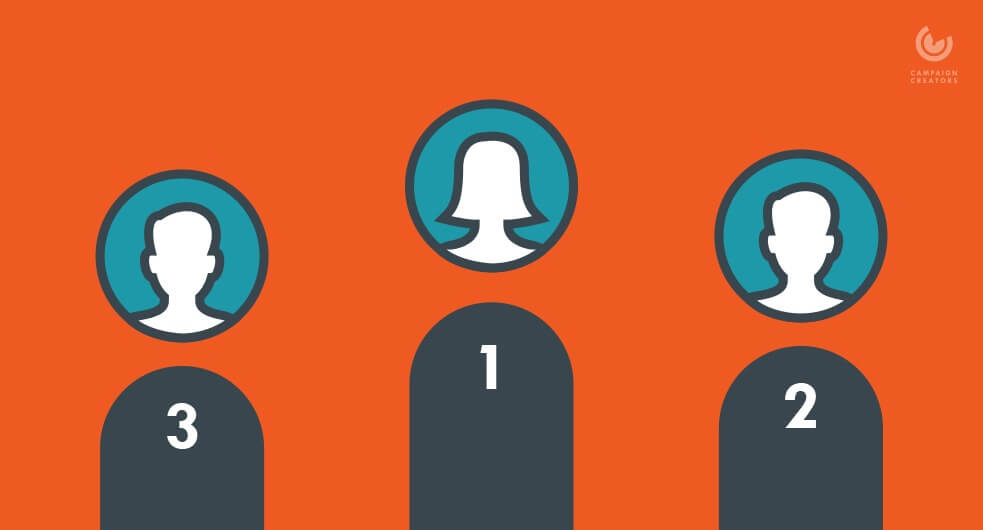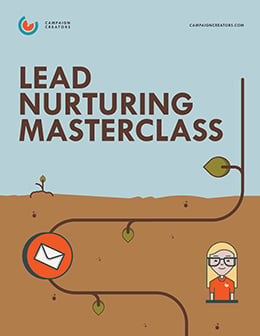Goal Setting
The foundation of a good lead nurturing process begins with deciding what kinds of goals should be set for your campaigns. Goals can be divided into two primary kinds.
Quantitative Goals
The most straightforward and easy to track, quantitative goals are numerically measurable. Quantitative metrics provide stepping stones on the path to measuring your success in an objective way, and can help with scaling lead nurturing efforts in the future.
Potential quantitative goals to consider include:
- Accelerating the sales cycle
- Increasing average customer lifetime value
- Improving conversion rate of leads to prospects
- Improve conversion rate of prospects to closed deals
- Reducing the number of leads rejected monthly by the sales team
- Increasing the rate of upsells and cross-sells with existing customers
These goals can be formulated as precise numbers, but it more reasonable to express them as percentages, to allow them to grow alongside the company and its database.
Qualitative Goals
While more general than quantitative goals, qualitative goals are important to incorporate into your strategy, as well; they aim to remind you of the bigger picture.
Examples of such objectives include:
- Better organizing and maintaining your lead database
- Allocating more attention/effort towards turning cold leads into warmer ones
- Engaging in more personal relationships and building greater trust with your prospects and buyers
- Collecting information from leads more efficiently
- Better collaborating with the sales team on defining qualified leads
To get an idea of what to base these goals on, it can be helpful to begin with a few analytical questions, including:
- What is the range of the products/services that your company offers? Industry benchmarks as well as historical data specific to your company, such as sale cycle patterns, can affect the expectations that should be set in major ways. The number of tracks in your lead nurturing program will rely on the diversity of offerings.
- How many leads do you generate currently? The scale of leads helps should determine the scale of the lead nurturing program, as well as the number of nurture segments created and the rigor of the nurturing schedule. Crucially, understanding what percentages of leads are “warm” (sales ready) when they enter your database allows you to measure current ROI.
- What are the main sources of those leads? This will help you decide what types of tracks to create and how to allocate efforts wisely.
- What are some major demographic and behavioral trends that can be observed among your leads? The earlier you can begin finding characteristics to organize leads into groups for buyer persona development, the better.
- What does your current nurturing process look like? How are leads responded to, distributed, and managed today? Assessing existing strengths and weaknesses early on is crucial; no nurturing strategy is built entirely from scratch. Direct feedback from sales and marketing teams will provide insight, along with running a data-based report with your marketing software.
Deciding Who to Nurture
Now that you’ve determined the goals that you would like to pursue with your lead nurturing campaign, it is time to focus on understanding and organizing the leads themselves.
Buyer Persona Development
Buyer personas are fictional, generalized representations of our ideal customers - their needs, pain points, goals, behavioral patterns, and demographics. They are based both on market research and company-collected data.
Personas play a crucial role in lead nurturing as they help us understand our customers (and prospective customers) better, and make it easier for us to tailor content to the specific needs, behaviors, and concerns of different types of buyers.
Buyers with the same persona face similar challenges (that you can help them solve), have similar goals (that you can help them meet), and similar objections to your product or service (that you will help them overcome). When creating your personas, think less about their demographics, at least at first, and more about their pain points.
Building buyer personas from scratch may seem overwhelming, but the process can be made simpler when broken down into a few key steps.
1. Starting Your Persona Research
Your final persona output will consist of several different subcategories. Challenges, common objections, demographic information, and marketing messaging are all common. But, it is important to learn who your personas are before labeling them with demographics.

You may think you’ve already got your ideal customers nailed down, but it’s certainly worth conducting a review. Engage with audiences relevant to your industry as well as those common to your company; webinars, newsletters, even a strategic Google keyword search can be good ways of obtaining information.
If your company is already fairly well-established, it is recommended to supplement these efforts with direct interviews with your current or former customers. They will eliminate much of the need for guesswork and extrapolation by providing information first-hand.
Additionally, while it is not necessary to ask for a one-on-one session with the entire database of buyers, it may be worthwhile to look into data that has been previously gathered through social media or surveys.
2. Psychographics: Challenges, Pain Points, a Day in the Life
Now it is time to conduct an analysis of your personas and their motivations. Consider what your personas may go through on a daily basis, and detail their behavioral tendencies around your product/service. There should be an initial consideration of why each of your personas needs your product/services, and how they developed their need in the first place. List out why your persona would even be open to using them.
Additionally, take time to pinpoint their complaints and “pain points,” which will provide insight into why they have been unable to solve their problem through other sources. This will allow you to offer the most relevant arguments for why your business can offer the solution they need.
In summary, to develop your persona's psychographic profile ask the following questions:
- What are this persona's pain points? In other words, what problems do you help them solve?
- What goals do your products or services help them meet? In other words, what do they have to gain from your product/services?
- What do they value most in life?What are their life goals?
- What are their interests/how do they spend their time?
- What are their dislikes?
- What are their most common objections to your product or service?
If this is a B2B persona you will want to answer additional questions specific to the workplace such as:
- What are their responsibilities at work?
- What are their goals at work?
- How is their job performance measured?
- What are their biggest internal challenges?
- What are their biggest external challenges?
3. Segmenting by Demographics
Once you've determined your persona's challenges and common objections you can outline their demographic information. This is typically the most straightforward and basic information that comes with each persona: their age, location, job title, salary, marital status, and any other straightforward details.
4. Deciding How Many Personas to Construct
There is no concrete number that will work for every business. Using fewer personas is often easier as it allows a more concise brand message; on the other hand, this reduces capacity for personalization. While it is impossible to be everything to everyone, creating a hierarchy of personas may be helpful. If you have a long list of personas, try to begin with what you consider to be your three most important personas, and then add more as needed over time.
5. Negative Personas
After your personas have been fleshed out, another kind of persona should be considered as a last step. Negative personas are potential customers that your company should look to avoid. Over the life of any business, it will become more and more apparent who offers the highest lifetime value to your company and who should probably be avoided in the future.
List Building (Lead Generation)
While this series is dedicated primarily to lead nurturing and not lead generation, it must be noted that an underlying requirement for implementing a nurturing process is to have a substantial database of leads. List building refers to the development and maintenance of this database.
The four components of the lead generation process are:
1. A visitor has discovered your business through one of your marketing channels, whether that’s your website, blog, or social media page. On these channels, you’ll need to have a customized call-to-action (CTA). A CTA is an image, button, or message that calls visitors to take some sort of action. When it comes to lead generation, this action is to navigate to a landing page.
2. A landing page is a web page a visitor lands on for a distinct purpose. While a landing page can be used for various reasons, one of its most frequent uses is to capture leads through a form.

3. Forms are hosted on landing pages. They consist of a series of fields that collect information in exchange for an offer.
4. An offer is the content or something of value that’s being offered on the landing page. The offer must have enough value to a visitor to merit providing their personal information in exchange for it.
After clicking the final submit button on the form, the visitor has successfully become a lead for your business or organization. Once you put all these elements together, you can use your various promotional channels to link and drive traffic to the landing page so you can start generating leads.
Places To Promote Your Marketing Offers For Lead Generation
- In PPC Campaigns: If you’re using pay-per-click (PPC) as a way to complement your organic SEO efforts, think of your PPC ads as simply CTAs for your offers. Follow best practices for creating calls-to-action, and you’ll enjoy better clickthrough rates and more leads from your PPC campaigns as well.
- Within Press Releases: If your business uses news releases as a way to promote information about your business, don’t overlook the opportunity they provide for lead generation. Just as you’d use anchor text (text that is visible and clickable in a hyperlink) in a blog post to point to a landing page, do the same in your news releases.
- On Social Media: Sharing links to your offers’ landing pages is the main way you can use social media for lead generation. Use the space that the specific social network allows to describe the value that fans and followers will get out of the offer.
- In an Email Signature: This will be particularly effective for your business’s sales team. Encourage them to add a brief text-based call-to-action at the end of their email signature to help nurture prospects with whom they’re communicating using more offers of free content in exchange for more information.
- On Your Blog: Just about every blog post you publish should have an opportunity to include a CTA. Again, try to align the content of the offer with the content of the blog post as best as you can in order to increase clickthroughs.
- On Website Pages: Link to your landing pages on various pages of your website through CTAs. Try to align the offer you link to with the goals of that page.
Sales and Marketing Alignment
Sales and marketing alignment is becoming increasingly more important. The buyer’s journey has evolved so that the sales portion of the journey comes much later than it used to. Studies have shown that up to 70% of a lead’s purchase decision has been made before they even come in contact with a salesperson.
There is, in fact, a distinction between a marketing and sales buyer persona. Marketing personas need to be created for marketing activities, and sales personas for sales activities; however, both can learn from the other.
As an example, imagine that you are in middle management for a company looking for project management software. Your CEO tasks you to find multiple different solutions for you to present to him to make a decision. In this case, you embody the marketing persona, and your CEO is the sales persona.
Lead Scoring
You’ve probably heard of lead scoring before, but let’s briefly review the definition.
Lead scoring is a customizable, rule-based system for ranking leads to distinguish which ones are cold, lukewarm, or red hot.
This provides your marketing and sales teams with a better idea of where to focus their efforts. (“Hotter” leads are close to converting, while “colder” ones require further nurturing or are unprepared/unqualified to make a purchase decision at the current time.) The challenge lies in determining the guidelines necessary for your personal system.
Now, we will delve into the essential framework of a successful lead scoring model. You'll likely notice that there are some similarities in approach between lead scoring and building buyer personas!

Implicit and Explicit Criteria
By taking both implicit and explicit criteria into account, you can get a well-rounded picture of the types of leads that stand out from the pool of candidates.
Explicit scoring involves using the information directly shared by a lead to gauge their level of qualification; for instance, information provided on a landing page form by a site visitor. Demographics often tie into this— profession, company size, initial contact source, etc.
Implicit scoring, on the other hand, is based on tracking the activity that drives a lead towards a sale to infer the lead's level of interest. In the modern marketing world, both the behavior and its tracking is primarily digital— typical tracked actions include most visited pages, emails opens, shared posts, and downloaded content.
Tiered Behavioral Scoring
The main function of an automated lead scoring model is to assign varying degrees of importance to actions that your leads take. The best way to start organizing these criteria is by compiling a full list of relevant lead behavior across different categories, which can include:
- your website
- email campaigns
- info forms
- downloadable content
- in-person events
- webinars
- direct interaction with company representatives
The next step is trickier; the actions in each category must be ranked by order of importance and assigned fitting point values. Is opening an email as significant as clicking through it on a link? Is visiting the home page of your company's site as important as approaching your booth at a trade show? Take time to think through the options.
Another aspect of behavioral lead qualification is distinguishing between global and local scoring. Lead scoring on a global level means that the same criteria is applied to every lead, on every occasion.
However, in cases where you are interested in looking into a particular lead more closely or collecting data on a more specific level, like the interactive content medium, it can be necessary to create separate scoring rules at the local, or campaign-specific level.

Demographic Scoring
Demographic lead qualification is based on the lead's identity rather than their behavior; while a static and thus less sophisticated element of your model, it is still essential and should not be overlooked. Relevant demographic criteria are details such as:
- the lead's country of origin
- industry
- position
- company size and type
- Revenue
When deciding what effect a particular demographic feature will have on the lead's score, it can be helpful to consult your buyer personas to understand the general profile of the person or business you would consider a good fit.
Negative Scoring and Degradation
While it is good to think positive and focus on making qualified leads' scores higher, not being discriminatory enough can result in an overall decrease in the quality of leads being marked as “qualified.” For this reason, it is important to implement negative lead scoring, which deducts points when leads meet certain disqualifying criteria.
From a demographic standpoint, for example, this can mean that the lead is in an unfitting industry or holds an unfavorable position (e.g., an associate-level employee rather than a decision maker). With behavioral criteria, points can be taken off for actions like the lead moving your company's emails to spam, or even putting a personal email address into your landing page form instead of a professional one.
Similarly, rules should be established for the degradation of a lead's score over a period of time if their behavior stagnates. This is not meant to be a punishment-- if your prospect isn’t interacting with your company, knowing when (or whether) to try to re-engage them is simply strategic.
Cooperation Between Marketing and Sales Teams
Finally, aligning the goals of your sales and marketing teams is imperative to creating a great lead qualification system. Sales should be involved in the process of establishing scoring criteria, and their opinion can be a valuable contribution to your definition of a “good” lead.
46% of B2B marketers have not set up a lead scoring threshold that will automatically alert or route leads to sales. This means that the handoff process is not streamlined, and is eating up precious time and resources for all involved. The solution? Collaborate to establish a threshold that your sales team has agreed upon, to ensure that leads are getting assigned properly.
Other Important Lead Scoring Elements
Using Automation for Lead Scoring
An automated lead scoring system automates all the processes we’ve just discussed and organizes them under a scaled points system. This can be achieved by connecting a lead scoring platform with something like a customer relationship management (CRM) platform.
Predictive Lead Scoring
Predictive lead scoring is a tool that uses an algorithm to predict who in your database is qualified or not qualified. Developing a consistent formula can be really difficult for many marketers, and often requires a lengthy testing process.
A predetermined algorithm, on the other hand, examines what information your customers have in common, as well as what information your leads that did not close have in common, then generates a formula automatically that attempts to predict future behavior. The information taken into account and the general construction of the algorithm depends on the specific provider.
Keeping Your Database Clean and Up to Date
Maintaining and regularly updating your lead database, which is most commonly stored and managed by a CRM, is imperative for ensuring that a nurturing strategy will continue to run smoothly. The process may seem tedious, but luckily, technology will be on your side when it comes to organizational and cleaning efforts (yet another reason why quality software is a worthwhile investment).
Let's review several key best practices for maintaining a clean database.
Determine Data Fields
Decisions about which data fields to include and prioritize can matter more than you think. When determining which data should be mandatory for a sufficiently insightful contact record, it is important to consider pieces of information such as source and number of contact channels (e.g. email, phone number, etc.).
Ideally, every entry's data fields should be fully complete. Remember to match these fields with the information requested by your lead capture forms, or to complete them gradually over the course of the relationship with a lead. In the case of manual data entry— as via phone conversation with a prospect— those collecting the data collect should know what to ask for first.

Check for Errors
Whether manual or automatic, mistakes are bound to occur in data entry on the ends of both leads and marketers. This is when a scrupulous pair of eyes becomes necessary to detect typographical issues, duplicate records, etc.
It is recommended to merge duplicate records in order to prevent data loss and avoid hassle in distinguishing which record contains the most up-to-date information. Additionally, make sure data is updated routinely— outdated information can cost valuable time later on, and businesses and individuals relocate or change contact information more often than you may think.
Don't Be Afraid to Remove Contacts
In certain cases, it's better to remove contacts than to keep them in the database. Entries that are missing crucial information, such as an email address or any other means of contacting the lead, are all but useless for marketing campaigns.
There are also leads that require more difficult decisions to be made; specifically, chronic email bounces and leads that have become inactive. Inactive leads are generally defined as not having interacted with your company for a determined period of time via site, emails, forms, or any other means of communication.
Unresponsive contacts can sabotage the accuracy of your email tracking and reporting; however, it is up to your judgment to determine the length of an inactive period that merits removing a lead from your base. For instance, leads that were created within a certain timeframe (say, a year or half a year or “x” months) have had ample time to become active.
Additionally, you may at times need to apply a case-by-case approach to decide whether a lead is worth a reengagement attempt or should simply be let go. B2B leads generally tend to require more invested effort, so it it wise to consider whether it is worth salvaging the relationship your company put a considerable amount of work into establishing.
Track Lead Source
Understanding where leads are entering the database allows you to hone in on the approach them with the right strategy. Organically sourced leads differ from those added from imported lists; leads who filled out a site form have a different exposure to your business than those who engaged in conversation directly with a representative. Tracking lead source provides insight into leads' identities and objectives, and facilitates a connection back to your buyer personas.
Mapping the Buyer's Journey
The buyer’s journey is typically a three-step process that aligns with the stages of your sales funnel. As a marketer, there is a good chance you have already studied it in the past! However, sometimes it is necessary to go back to basics in order to better keep existing frameworks in mind when fleshing out your lead nurturing strategy. As a refresher, the buyer's journey consists of the following stages:
TOFU: The Awareness Stage
At the top of the funnel, or TOFU, is the Awareness stage. This is where people are looking for answers, resources, and insight on a problem they are trying to solve, an answer they are seeking or a goal they want met.
Some questions to ask in order to better understand the Awareness stage include:
- How do buyers describe this goal or pain point? (in their words; it may not be how you refer to it internally)
- What are the top causes for this pain point or reasons this goal is not being met?
- What does your buyer have to gain if this pain point is addressed or goal is met?
- What are the consequences of inaction by the buyer?
- Are there common misconceptions buyers have about addressing the goal or challenge? (where might there be push back)
- How do buyers decide whether the goal or challenge should be prioritized?
- How do buyers educate themselves on this goal or challenge? (where do they look for information, what types or formats of information speak to them)
MOFU: The consideration Phase
At the middle of funnel, or MOFU, is the Consideration stage. This is where people are considering the possible solutions for their problem or ways to meet their goal. And once they have determined the best solution, they begin an evaluation of the providers of those solutions.
Questions for assessing the Consideration stage for your buyer:
- What categories of solutions do buyers investigate?
- How do buyers educate themselves on the various categories?
- How do buyers perceive the pros and cons of each category?
- How do buyers decide which category is right for them?
BOFU: The Decision Phase
At the bottom of funnel, or BOFU, is the Decision stage. This is where people are making an actual purchase decision. Your potential customer has chosen the category of solutions to address their problem or goal - the “what”- but they need to determine which one -the “who”- can best provide that solution.
Questions you should ask yourself to define the Decision stage include:
- What criteria do buyers use to evaluate the available offerings?
- When buyers investigate your company’s offering, what do they like about it compared to alternatives? What concerns do they have with your offering?
- Who needs to be involved in the decision? For each person involved, how does their perspective on the decision differ?
- Do buyers have expectations around trying the offering before they purchase it?
- Outside of purchasing, do buyers need to make additional preparations, such as implementation plans or training strategies?
Feel like you have a better understanding of the lead nurturing process? Take your learning to the next level by applying your knowledge in the Lesson 2 Exercise below.
Lesson 2 Exercise
Part 1: Create Your Buyer Personas
If you do not have documented buyer personas, that is the first place to start. Using the framework in the section Buyer Persona Development create your top 1-3 most important buyer personas. Remember, the most pertinent information to include in a persona profile is their pain points, goals, values, and common objections—not their demographics.
Part 2: Map Out Your Buyer's Journey
Now that you know who your buyer personas are, you need to document their journey. Choose one of your buyer persona’s and map out the buyer’s journey for a product or service that solves their pain point. To do this, refer to the section Mapping Out the Buyer’s Journey and answer the series of questions listed for each stage: awareness, consideration, and decision.
Now the goal of your lead nurturing strategy is to guide your potential buyer through these stages. To do this effectively and efficiently you will need to invest in marketing automation software. Which lucky for you, is the subject of Lesson 3.




